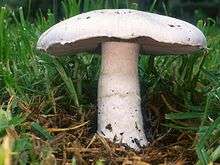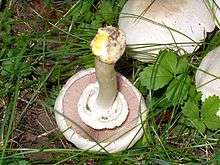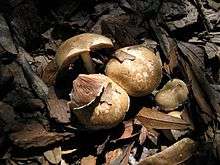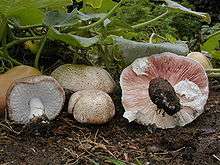Agaricus
Agaricus is a genus of mushrooms containing both edible and poisonous species, with possibly over 300 members worldwide.[2][3] The genus includes the common ("button") mushroom (Agaricus bisporus) and the field mushroom (A. campestris), the dominant cultivated mushrooms of the West.
| Agaricus | |
|---|---|
 | |
| Agaricus campestris | |
| Scientific classification | |
| Kingdom: | Fungi |
| Division: | Basidiomycota |
| Class: | Agaricomycetes |
| Order: | Agaricales |
| Family: | Agaricaceae |
| Genus: | Agaricus L.:Fr. emend Karst. |
| Type species | |
| Agaricus campestris L.:Fr. | |
| Synonyms[1] | |
Members of Agaricus are characterized by having a fleshy cap or pileus, from the underside of which grow a number of radiating plates or gills on which are produced the naked spores. They are distinguished from other members of their family, Agaricaceae, by their chocolate-brown spores. Members of Agaricus also have a stem or stipe, which elevates it above the object on which the mushroom grows, or substrate, and a partial veil, which protects the developing gills and later forms a ring or annulus on the stalk.
Taxonomy
For many years, members of the genus Agaricus were given the generic name Psalliota, and this can still be seen in older books on mushrooms. All proposals to conserve Agaricus against Psalliota or vice versa have so far been considered superfluous.[4]
Several origins of Agaricus have been proposed. It possibly originates from ancient Sarmatia Europaea, where people Agari, promontory Agarum and a river Agarus were known (all located on the northern shore of Sea of Azov, probably, near modern Berdiansk in Ukraine).[5][6][7] Note also Greek ἀγαρικόν, "a sort of tree fungus" (There has been an Agaricon Adans. genus, treated by Donk in Persoonia 1:180.)
Dok reports Linnaeus' name is devalidated (so the proper author citation apparently is "L. per Fr., 1821") because Agaricus was not linked to Tournefort's name. Linnaeus places both Agaricus Dill. and Amanita Dill. in synonymy, but truly a replacement for Amanita Dill., which would require A. quercinus, not A. campestris be the type. This question is compounded because Fries himself used Agaricus roughly in Linnaeus' sense (which leads to issues with Amanita), and A. campestris was eventually excluded from Agaricus by Karsten and was apparently in Lepiota at the time Donk wrote this, commenting that a type conservation might become necessary.[8]
The alternate name for the genus, Psalliota, derived from the Greek psalion/ψάλιον, "ring", was first published by Fries (1821) as trib. Psalliota. The type is Agaricus campestris (widely accepted, except by Earle, who proposed A. cretaceus). Paul Kummer (not Quélet, who merely excluded Stropharia) was the first to elevate the tribe to a genus. Psalliota was the tribe containing the type of Agaricus, so when separated, it should have caused the rest of the genus to be renamed, but this is not what happened.[9]
Phylogenetics
The use of phylogenetic analysis to determine evolutionary relationships amongst Agaricus species has increased the understanding of this taxonomically difficult genus, although much work remains to be done to fully delineate infrageneric relationships. Prior to these analyses, the genus Agaricus, as circumscribed by Rolf Singer, was divided into 42 species grouped into five sections based on reactions of mushroom tissue to air or various chemical reagents, as well as subtle differences in mushroom morphology.[10] Restriction fragment length polymorphism analysis demonstrated this classification scheme needed revision.[11]
Sections
This genus is divided into several sections:
- Contains 19 species in six subgroups similar to the horse mushroom, A. arvensis, it has versatile heterothallic life cycles.[12]
- Section Xanthodermatei
- Outlined by Singer in 1948, this section includes species with various characteristics similar to the type species A. xanthodermus.[13] The section forms a single clade based on analysis of ITS1+2.[14]
- Section Chitonioides
- Section Sanguinolenti
- Section Spissicaules (Hainem.) Kerrigan
- Section Duploannulatae
- Based on DNA analysis of ITS1, ITS2, and 5.8S sequences, this section (also known as section Hortenses) may be divided into six distinct clades, five of which correspond to well-known species from the temperate Northern Hemisphere: A. bisporus, A. subfloccosus, A. bitorquis, A. vaporarius and A. cupressicola. The sixth clade comprises the species complex A. devoniensis.[15]
List of species
The fungal genus Agaricus contains about 200 species worldwide.[16]




- Agaricus abruptibulbus Peck (1905) – abruptly bulbous agaricus
- Agaricus agrinferus Kerrigan & Callac (2008)
- Agaricus albolutescens Zeller (1938)
- Agaricus aestivalis Pilat (1951)
- Agaricus agrinferus Kerrigan & Callac – California[17]
- Agaricus angusticystidiatus[18]
- Agaricus annae[19]
- Agaricus alabamensis – North America[20]
- Agaricus albertii Bon (1988)
- Agaricus altipes Møller (edible)[21]
- Agaricus amicosus
- Agaricus andrewii Freeman (choice edible)[21]
- Agaricus arcticus
- Agaricus argenteus
- Agaricus argentinus[22]
- Agaricus aridicola Geml, Geiser & Royse (2004)[23]
- Agaricus aristocratus
- Agaricus arorae
- Agaricus arvensis – horse mushroom
- Agaricus augustus – the prince
- Agaricus aurantioviolaceus
- Agaricus benesii
- Agaricus bernardii – salt-loving mushroom
- Agaricus biannulatus Mua, L.A.Parra, Cappelli & Callac (2012) – Europe[24]
- Agaricus bisporiticus – Asia[25]
- Agaricus bisporus – cultivated mushroom
- Agaricus bitorquis – pavement mushroom
- Agaricus blazei
- Agaricus bohusianus L.A.Parra (2005) – Europe[26]
- Agaricus bohusii
- Agaricus bresadolanus
- Agaricus caballeroi L.A.Parra, G.Muñoz & Callac (2014) – Spain[27]
- Agaricus californicus[28]
- Agaricus campbellensis[29]
- Agaricus campestris – field mushroom, meadow mushroom (US)
- Agaricus cellaris
- Agaricus chartaceus[30]
- Agaricus chionodermus[19]
- Agaricus chlamydopus
- Agaricus colpeteii[31]
- Agaricus columellatus[32]
- Agaricus comtuliformis[20]
- Agaricus comtulus
- Agaricus cretacellus
- Agaricus cretaceus
- Agaricus crocodilinus
- Agaricus cupreobrunneus – brown field mushroom
- Agaricus cupressophilus Kerrigan (2008) – California[17]
- Agaricus depauperatus
- Agaricus deserticola G.Moreno, Esqueda & Lizárraga (2010) – gasteroid agaricus
- Agaricus devoniensis
- Agaricus diminutivus
- Agaricus dulcidulus – rosy wood mushroom
- Agaricus eburneocanus[30]
- Agaricus endoxanthus[33]
- Agaricus erthyrosarx[30]
- Agaricus essettei
- Agaricus excellens
- Agaricus fissuratus
- Agaricus freirei – Spain[34]
- Agaricus fuscofibrillosus
- Agaricus fuscovelatus
- Agaricus floridanus
- Agaricus fuscopunctatus – Thailand[25]
- Agaricus halophilus
- Agaricus hondensis
- Agaricus hortensis
- Agaricus huijsmanii Courtec. (2008)
- Agaricus inilleasper[30]
- Agaricus impudicus
- Agaricus inapertus
- Agaricus koelerionensis
- Agaricus lacrymabunda
- Agaricus lamelliperditus[31]
- Agaricus langei
- Agaricus lanipes
- Agaricus laskibarii[35]
- Agaricus leucotrichus Møller (edible)[36]
- Agaricus lilaceps – cypress agaricus
- Agaricus litoralis – coastal mushroom
- Agaricus ludovici[37]
- Agaricus luteomaculatus
- Agaricus maclovianus[38]
- Agaricus macrocarpus
- Agaricus macrolepis (Pilát & Pouzar) Boisselet & Courtec. (2008)
- Agaricus magni
- Agaricus maleolens
- Agaricus medio-fuscus
- Agaricus meleagris
- Agaricus menieri
- Agaricus micromegathus (edible)[39]
- Agaricus microvolvatulus
- Agaricus minimus
- Agaricus moelleri – inky mushroom
- Agaricus murinocephalus – Thailand[40]
- Agaricus nebularum – South America[41]
- Agaricus niveolutescens
- Agaricus osecanus
- Agaricus pachydermus[30]
- Agaricus pampeanus
- Agaricus parvitigrinus[42]
- Agaricus pattersoniae – California
- Agaricus perobscurus
- Agaricus perrarus
- Agaricus phaeolepidotus
- Agaricus pilatianus
- Agaricus pilosporus
- Agaricus placomyces
- Agaricus pocillator
- Agaricus porphyrizon
- Agaricus porphyrocephalus Møller (edible)[43]
- Agaricus praerimosus
- Agaricus pratensis
- Agaricus pseudopratensis
- Agaricus purpurellus
- Agaricus radicatus
- Agaricus romagnesii
- Agaricus rosalamellatus[44]
- Agaricus rotalis
- Agaricus rubellus
- Agaricus rufotegulis
- Agaricus rusiophyllus
- Agaricus santacatalinensis[45] – Brazil
- Agaricus semotus
- Agaricus silvaticus – scaly wood mushroom, blushing wood mushroom, or pinewood mushroom
- Agaricus silvicola Peck (1872) – wood mushroom
- Agaricus smithii
- Agaricus solidipes Peck, Bull (1904) (edible)[46]
- Agaricus spissicaulis
- Agaricus stigmaticus Courtec. (2008)
- Agaricus stramineus
- Agaricus subantarcticus[29]
- Agaricus subfloccosus
- Agaricus subperonatus
- Agaricus subrufescens (= Agaricus blazei) – almond mushroom, mushroom of the sun, God's mushroom, mushroom of life, royal sun agaricus
- Agaricus subrutilescens – wine-colored agaricus
- Agaricus subsaharianus L.A.Parra, Hama & De Kesel (2010)
- Agaricus subsubensis Kerrigan (2008) – California[17]
- Agaricus taeniatus – China[47]
- Agaricus tlaxcalensis Callac & G.Mata (2008) – Tlaxcala[17]
- Agaricus urinascens
- Agaricus vaporarius
- Agaricus variegans
- Agaricus valdiviae[48][49]
- Agaricus xanthodermulus [42]
- Agaricus xanthodermus – yellow-staining mushroom
- Agaricus xantholepis [50]
Echigoshirayukidake (Basidiomycetes-X) is also thought to be in Agaricus, either as a subspecies of Agaricus blazei[51] or a new species.[52]
Edibility and toxicity
The genus contains the most widely consumed and best-known mushroom today, A. bisporus, with A. campestris also being well known. A. porphyrocephalus is a choice edible,[43] and some others are edible as well.[53]
The most notable inedible species is the yellow-staining mushroom, A. xanthodermus. One species reported from Africa, A. aurantioviolaceus, is reportedly deadly poisonous.[54]
Reacting to some distributors marketing dried agaricus or agaricus extract to cancer patients, it has been identified by the U.S. Food and Drug Administration as a "fake cancer 'cure'".[55]
See also
- List of Agaricus species
References
- "Synonymy: Agaricus L., Sp. pl. 2: 1171 (1753)". Index Fungorum. CAB International. Retrieved 2013-08-29.
- Bas C. (1991). A short introduction to the ecology, taxonomy and nomenclature of the genus Agaricus, 21–24. In L.J.L.D. Van Griensven (ed.), Genetics and breeding of Agaricus. Pudoc, Wageningen, The Netherlands.
- Capelli A. (1984). Agaricus. L.: Fr. (Psalliota Fr.). Liberia editrice Bella Giovanna, Saronno, Italy
- Wakesfield E. (1940). "Nomina genérica conservando. Contributions from the Nomenclature Committee of the British Mycological Society, III". Transactions of the British Mycological Society. 24 (3–4): 282–293. doi:10.1016/s0007-1536(40)80028-4.
- Rolfe R. T., Rolfe F. W. (1874). "The derivation of fungus names". The Romance of the Fungus World. Courier Corporation. pp. 292–293. ISBN 9780486231051.CS1 maint: uses authors parameter (link)
- R. Talbert, ed. (2000). "Map 84. Maeotis". Barrington Atlas of the Greek and Roman World. Princeton University Press.
- W. Smith, ed. (1854). "Agari". Dictionary of Greek and Roman Geography. Vol.I. Boston: Little, Brown, and Company. p. 72. (on Google Books, on archive.org)
- Donk, M.A. (1962). "The generic names proposed for Agaricaceae". Beiheifte zur Nova Hedwigia. 5: 1–320. ISSN 0078-2238.
- Donk, M.A. (1962). "The generic names proposed for Agaricaceae". Beiheifte zur Nova Hedwigia 5: 1–320. ISSN 0078-2238
- Singer, Rolf (1987). Agaricales in Modern Taxonomy. Lubrecht & Cramer Ltd. ISBN 978-3-7682-0143-8.
- Bunyard BA, Nicholson MS, Royse DJ (December 1996). "Phylogeny of the genus Agaricus inferred from restriction analysis of enzymatically amplified ribosomal DNA". Fungal Genet Biol. 20 (4): 243–53. doi:10.1006/fgbi.1996.0039. PMID 9045755.CS1 maint: uses authors parameter (link)
- Calvo-Bado L, Noble R, Challen M, Dobrovin-Pennington A, Elliott T (February 2000). "Sexuality and Genetic Identity in the Agaricus Section Arvenses". Appl. Environ. Microbiol. 66 (2): 728–34. doi:10.1128/AEM.66.2.728-734.2000. PMC 91888. PMID 10653743.CS1 maint: uses authors parameter (link)
- Singer R (1948). "Diagnoses Fungorum Novorum Agaricalium". Sydowia. 2: 26–42.
- Kerrigan RW, Callac P, Guinberteau J, Challen MP, Parra LA (2005). "Agaricus section Xanthodermatei: a phylogenetic reconstruction with commentary on taxa". Mycologia. 97 (6): 1292–315. doi:10.3852/mycologia.97.6.1292. PMID 16722221.CS1 maint: uses authors parameter (link)
- Challen MP, Kerrigan RW, Callac P (2003). "A phylogenetic reconstruction and emendation of Agaricus section Duploannulatae". Mycologia. 95 (1): 61–73. doi:10.2307/3761962. JSTOR 3761962. PMID 21156589.CS1 maint: uses authors parameter (link)
- Kirk PM, Cannon PF, Minter DW, Stalpers JA (2008). Dictionary of the Fungi (10th ed.). Wallingford, UK: CAB International. p. 13. ISBN 978-0-85199-826-8.
- Kerrigan RW, Callac P, Parra LA (2008). "New and rare taxa in Agaricus section Bivelares (Duploannulati)". Mycologia. 100 (6): 876–92. doi:10.3852/08-019. PMID 19202842.
- He, Mao-Qiang; Chuankid, Boontiya; Hyde, Kevin D.; Cheewangkoon, Ratchadawan; Zhao, Rui-Lin (2018). "A new section and species of Agaricus subgenus Pseudochitonia from Thailand". MycoKeys. 40 (40): 53–67. doi:10.3897/mycokeys.40.26918. PMC 6160818. PMID 30271264.
- Pilát A. (1951). The Bohemian species of the genus Agaricus. Prague, 142 pp.
- Murrill WA (1922). "Dark-spored agarics: III. Agaricus". Mycologia. 14 (4): 200–221. doi:10.2307/3753642. JSTOR 3753642.
- Phillips 2010, p. 219.
- (1899). Spegazzini C. (1899). Fungi argentini novi vel critici. Anales Mus. Nac. Buenos Aires 24: 167–186.
- Geml J, Geiser DM, Royse DJ (2004). "Molecular evolution of Agaricus species based on ITS and LSU rDNA sequences". Mycological Progress. 3 (2): 157–76. doi:10.1007/s11557-006-0086-8.
- Parra LA, Mua A, Cappelli A, Callac P (2012). "Agaricus biannulatus sp. nov., una nuova specie della sezione Xanthodermatei raccolta in Sardegna e Sicilia". Micologia e Vegetazione Mediterranea (in Italian). 26 (1): 3–30.
- Thongklang N, Nawaz R, Khalid AN, Chen J, Hyde KD, Zhao R, Parra LA, Hanif M, Moinard M, Callac P (2014). "Morphological and molecular characterization of three Agaricus species from tropical Asia (Pakistan, Thailand) reveals a new group in section Xanthodermatei". Mycologia. 106 (6): 1220–32. doi:10.3852/14-076. PMID 25152000.
- Parra LA (2005). "Nomenclatural study of the genus Agaricus L. (Agaricales, Basidiomycotina) of the Iberian Peninsula and Balearic Islands". Cuadernos de Trabajo Flora Micológica Ibérica. 21: 3–101.
- Parra LA, Muñoz G, Callac P (2014). "Agaricus caballeroi sp. nov., una nueva especie de la sección Nigrobrunnescentes recolectada en España". Micologia e Vegetazione Mediterranea (in Spanish). 29 (1): 21–38.
- Peck CH (1895). "New species of Fungi". Bulletin of the Torrey Botanical Club. 22 (5): 198–211. doi:10.2307/2478162. JSTOR 2478162.
- Geml J, Laursen GA, Nusbaum HC, Taylor DL (2007). "Two new species of Agaricus from the subantarctic". Mycotaxon. 100: 193–208.
- Lebel T, Syme A (2011). "Sequestrate species of Agaricus and Macrolepiota from Australia: new species and combinations, and their position in a calibrated phylogeny". Mycologia. 104 (2): 496–520. doi:10.3852/11-092. PMID 22067305.
- Lebel T. (2013). "Two new species of sequestrate Agaricus (section Minores) from Australia". Mycological Progress. 12 (4): 699–707. doi:10.1007/s11557-012-0879-x.
- Bates ST, Chapman RM, Islam MB, Schwabe A, Wardenaar ECP, Evenson VS (2016). "Phylogenetic placement of the secotioid fungus Araneosa columellata within Agaricus". Mycotaxon. 131 (1): 103–110. doi:10.5248/131.103.
- Parra LA, Villarreal M, Esteve-Raventos F (2002). "Agaricus endoxanthus una specie tropicale trovata in Spagna". Rivista di Micologia. 45 (3): 225–233.
- Blanco-Dios JB. (2001). "Agaricales des dunes de Galice (nord-ouest de l'Espagne). 1. Agaricus freirei Blanco-Dios, sp. nov". Documents Mycologiques (in French). 31 (127): 27–34.
- Parra LA, Arrillaga P (2002). "Agaricus laskibarii. A new species from French coastal sand-dunes of Seignosse". Doc Mycol. 31 (124): 33–38.
- Phillips 2010, p. 223.
- Remy L (1964). "Contribution a l'etude de la Flore mycologique Briangonnaise (Basidiomycetes et Discomycetes)". Bull. Trimestriel Soc. Mycol. France. 80: 459–585.
- Nauta MM (1999). "The Mycoflora of the Falkland Islands: II. Notes on the genus Agaricus". Kew Bulletin. 54 (3): 621–635. doi:10.2307/4110859. JSTOR 4110859.
- Phillips 2010, p. 224.
- Zhao R-L, Desjardin DE, Callac P, Parra LA, Guinberteau J, Soytong K, Karunarathna S, Zhang Y, Hyde KD (2012). "Two species of Agaricus sect. Xanthodermatei from Thailand". Mycotaxon. 122: 122–95. doi:10.5248/122.187.
- Singer R. (1969). Mycoflora australis. Beihefte zur Nova Hedwigia. 29. Lehre, Germany: Cramer. p. 165.
- Callac P, Guinberteau J (2005). "Morphological and molecular characterization of two novel species of Agaricus section Xanthodermatei". Mycologia. 97 (2): 416–24. doi:10.3852/mycologia.97.2.416. PMID 16396349.
- Phillips 2010, p. 220.
- Raithelhuber J (1986). "Nomina nova". Metrodiana. 14: 22.
- Albertó E. (1998). "Agaricus santacatalinensis a new species from Argentina". Mycotaxon. 66: 205–14.
- Murrill, William (1922). "Dark-Spored Agarics". Mycologia. New York Botanical Garden. 14: 203.
- Sai-Fei L, Ya-Li X, Cai-Xai Q, Qian-Qian L, Sheng-Long W, Guo-Jie L, Dong Z, Shao-Jie L, Hua-An W (2014). "Agaricus taeniatus sp. nov., a new member of Agaricus sect. Bivelares from northwest China". Mycotaxon. 129: 187–96. doi:10.5248/129.187.
- Singer R, Moser M (1965). "Forest mycology and forest communities in South America". Mycopathol. Mycol. Appl. 26 (2–3): 129–191. doi:10.1007/BF02049773.
- Heinemann P (1986). "Agarici Austroamericani VI. Apernu sur les Agaricus de Patagonie et de la Terre de Feu". Bull. Jard. Bot. Belg. 56 (3/4): 417–446. doi:10.2307/3668202. JSTOR 3668202.
- Gerault A. (2005). Florule evolutive des basidiomycotina du Finistere – Homobasidiomycetes – Agaricales: 22.
- US 6120772A, Hitoshi Ito & Toshimitsu Sumiya, "Oral drugs for treating AIDS patients", issued 2000-09-19
- Watanabe, T; Nakajima, Y; Konishi, T (2008). "In vitro and in vivo anti-oxidant activity of hot water extract of basidiomycetes-X, newly identified edible fungus" (PDF). Biological & Pharmaceutical Bulletin. 31 (1): 111–7. doi:10.1248/bpb.31.111. PMID 18175952. Retrieved 3 April 2018.
- Phillips 2010, pp. 219, 223.
- Walleyn R, Rammeloo J. (1994). The Poisonous and Useful Fungi of Africa South of the Sahara. Scripta Botanica Belgica. 10. National Botanic Garden of Belgium. p. 10. ISBN 978-90-72619-22-8.CS1 maint: uses authors parameter (link)
- "187 Fake Cancer 'Cures' Consumers Should Avoid". U.S. Food and Drug Administration. Archived from the original on May 2, 2017. Retrieved May 20, 2020.
Sources
- Phillips, Roger (2010). Mushrooms and Other Fungi of North America. Buffalo, NY: Firefly Books. ISBN 978-1-55407-651-2.CS1 maint: ref=harv (link)
External links
| Wikispecies has information related to Agaricus |
| Wikimedia Commons has media related to Agaricus. |
- MycoKey - The Genus Agaricus
- Mushroom Expert - The Genus Agaricus
- Varieties of California, USA on MYKOWEB .com
- Agaricus page at Index Fungorum
- On-line nomenclature of Agaricus from Royal Botanic Garden, Madrid. CSIC







